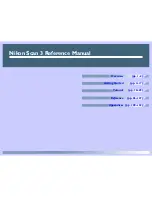
FLASH CS3
User Guide
307
If you’re creating a simple video presentation with linear narration and little to no interaction, accept the default
setting and import the video to the Stage. To create a more dynamic presentation, work with multiple video clips, or
add dynamic transitions or other elements using ActionScript, import the video into the library. After a video clip is
in the library, customize it by converting it into a MovieClip object that you can more easily control with Action-
Script.
By default, Flash expands the Timeline to accommodate the playback length of the video clip you are embedding.
6
(Optional) To edit your video clip before embedding it in the Timeline, select Edit Video First.
7
(Optional) If the video clip is not yet encoded in the FLV format, select a Flash Video encoding profile.
8
Click Finish.
The Video Import wizard encodes your video into the FLV format, and embeds the video into the SWF file. The
video appears either on the Stage or in the library depending on the embedding options you chose.
9
In the Property inspector (Window
> Properties), give the video clip an instance name, and make any modifica-
tions to the video clip’s properties.
Update an embedded video clip after editing it in an external editor
1
Select the video clip in the Library panel.
2
Select Properties and click Update.
The embedded video clip is updated with the edited file. The compression settings you selected when you first
imported the video are reapplied to the updated clip.
Import linked QuickTime video files
A linked QuickTime video imported into Flash does not become part of the Flash file. Instead, Flash maintains a
pointer to the source file.
If you link to a QuickTime video, publish the SWF file as a QuickTime video. You cannot display a linked QuickTime
clip in SWF format. The QuickTime file contains a Flash track, but the linked video clip remains in QuickTime
format.
You can scale, rotate, and animate a linked QuickTime video in Flash. However, you cannot tween linked QuickTime
video content in Flash.
Note:
The QuickTime Player does not support Flash Player files later than version 5.
See also
“About QuickTime” on page 452
“Specify publish settings for QuickTime videos” on page 430
Import a QuickTime video as a linked file
1
Do one of the following:
•
To link the video clip directly to the current Flash document, select File > Import > Import To Stage.
•
To link the video clip to the library for the current Flash document, select File > Import > Import To Library.
2
Select Link To External Video File, and click Next.
















































